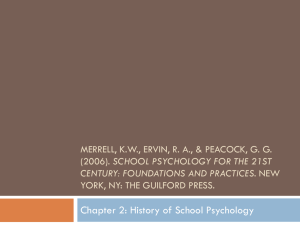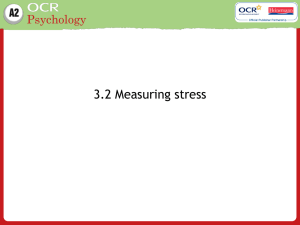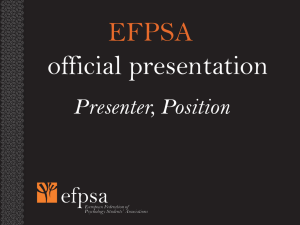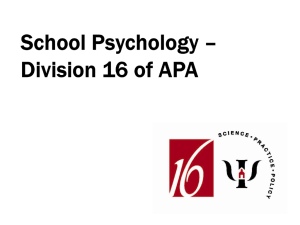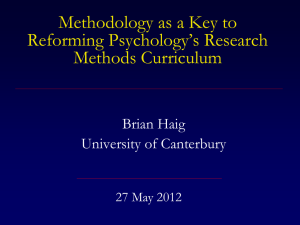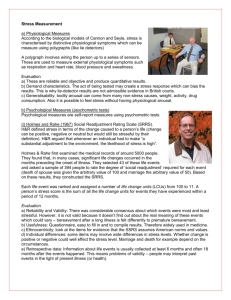3.1 Causes of stress - School
advertisement
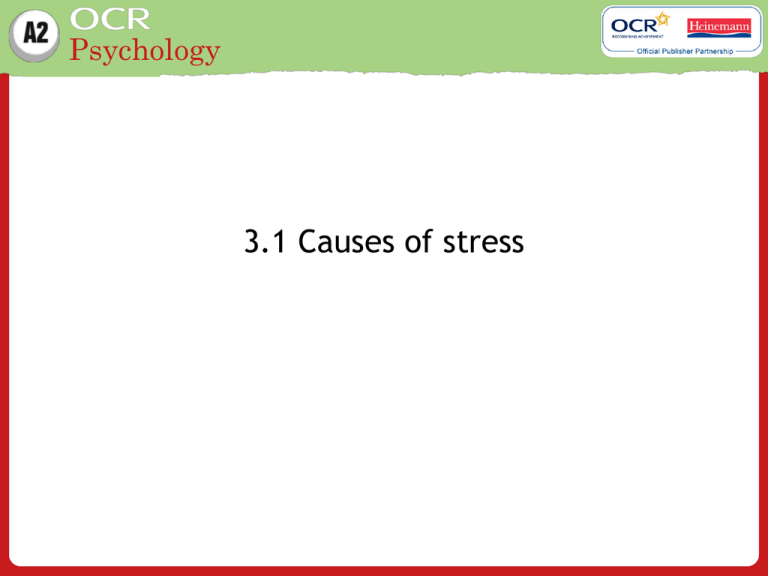
Psychology 3.1 Causes of stress Psychology Learning outcomes Understand the following three studies on causes of stress: • Work (Johansson et al. (1978) ‘Social psychological and neuroendocrine stress reactions in highly mechanised work’, Ergonomics 21 (8), 583–99); • Hassles and life events (Kanner et al. (1981) ‘Comparison of two modes of stress measurement’, Journal of Behavioural Medicine 4 (1), 1–39); • Lack of control (Geer, J. and Maisel, E. (1972) ‘Evaluating the effects of the prediction-control confound’, Journal of Personality and Social Psychology 23 (3), 314–19). Psychology Work Key study: Johansson et al. (1978) Aim • To measure the psychological and physiological stress response in two categories of employees. Method • A quasi-experiment where workers were defined as being at high risk (of stress) or in a control group. Psychology Participants • 24 workers at a Swedish sawmill. •The high-risk group was 14 workers who had to work at a set pace. Their job was complex and they were responsible for their own and their team’s wages. •The control group was 10 workers who were cleaners or maintenance men. Psychology Design • An independent design with participants already working in one of the two categories, so no manipulation of the independent variable. Psychology Procedure • Each participant was asked to give a daily urine sample when they arrived at work and at four other times during the day. They also gave selfreports of mood and alertness plus caffeine and nicotine consumption. • The baseline measurements were taken at the same time on a day when the workers were at home. Psychology Procedure (cont.) • Catecholamine (adrenaline) levels were measured in the urine. • Body temperature was measured at the time of urine collection. • Self-rating scales of words such as ‘sleepiness’, ‘wellbeing’, ‘irritation’ and ‘efficiency’ were made on scales from none to maximal (the highest level the person had ever experienced). • Caffeine and nicotine consumption were noted. Psychology Findings • The high-risk group had adrenaline levels twice as high as their baseline and these continued to increase throughout the day. The control group had a peak level of 1½ times baseline level in the morning and this then declined during the rest of their shift. • In the self-report, the high-risk group felt more rushed and irritated than the control group. They also rated their wellbeing lower than the control group. Psychology Conclusions • The repetitive, machine-paced work, which was demanding in attention to detail and was highly mechanised, contributed to the higher stress levels in the high-risk group. Psychology Hassles Key Study: Kanner et al. (1981) Aim • To compare the Hassles and Uplift Scale and the Berkman Life Events Scale as predictors of psychological symptoms of stress. Method • Longitudinal study using self-report and psychometric tests. Psychology Participants • 100 people from California. Design • A repeated design as participants completed both self-reports. Psychology Procedure • All tests were sent out by post one month before the study began. • The participants were asked to complete: • The Hassles rating every month for nine months. • The Life Events rating after ten months. • The Hopkins Symptom Checklist (HSCL) and the Bradburn Morale Scale every month for nine months. Psychology Findings • Hassles were consistent from month to month. • For men, life events positively correlated with hassles and negatively with uplifts. • For women, life events positive correlated with hassles and uplifts. • Hassle frequency positively correlated with psychological symptoms on the HSCL. Psychology Conclusions • Hassles are a more powerful predictor of psychological symptoms than life events. • Hassles contribute to psychological symptoms whatever life events have happened. Psychology Lack of control Key study: Geer and Meisel (1972) Aim • To see if perceived control or actual control can reduce stress reactions to aversive stimuli (photos of crash victims). Method • Laboratory experiment. Psychology Participants • 60 psychology undergraduates from New York University. Design • Independent design as participants were randomly assigned to one of three conditions. Psychology Procedure • Each participant was seated in a sound-shielded room and wired up to galvanic skin response (GSR) and heart-rate monitors. • Group 1 were given actual control over how long they saw each photograph for. • Group 2 were yoked to the actual control group, warned how long the photos would be shown for and that a noise would precede them. • Group 3 were also yoked to actual control group, but were told that that from time to time they would see photographs and hear tones. Psychology Findings • The predictability group (Group 2) were most stressed by the tone as they knew what was coming, but did not have control over the photograph. • The control group (Group 1) were less stressed by the photograph than the predictability group and no-control group (Groups 1 and 2) as they had control. Psychology Conclusions • It is likely that having the control to terminate aversive stimuli reduces the stressful impact of those stimuli.
